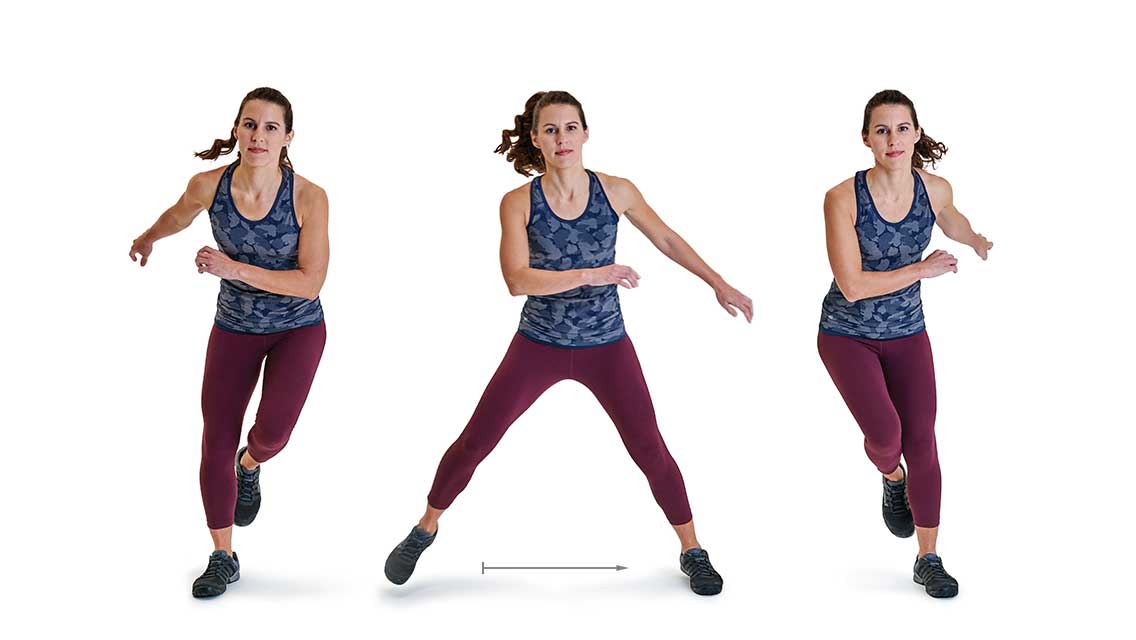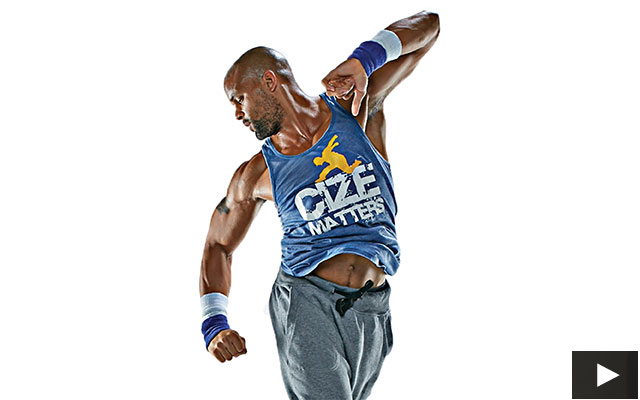Explore the moves:
Side-to-Side Squat ⋅ Jumping Jacks ⋅ Hinge to Row ⋅ Lateral Jump ⋅ Side-to-Side Pushups ⋅ Burpee
In a world where the demands of deadlines, long commutes, and loved ones in need of dinner loom alongside the pervasive myth that exercising for less than an hour isn’t worth the trouble, speedy workouts that truly work are a blessing.
Welcome to our six-move circuit, which can expand from just six minutes to 12 or 18 to suit your schedule and fitness level. High on intensity, low on equipment, and variable in impact, this workout is designed with the time-crunched in mind. But the benefits far exceed the convenience.
Fast workouts improve power — your ability to complete a lot of work in a short period of time — says workout designer Artemis Scantalides, founder of Iron Body Training Systems in Las Vegas. And power, she explains, is an oft-neglected skill essential to both athletics and everyday life, whether you’re chasing down a forehand shot or running to catch a bus.
Power training is also useful for burning fat, improving cardio capacity, and training fast-twitch muscle fibers, which dictate strength improvements and build muscle mass.
Scantalides created this workout around time constraints rather than a prescribed number of reps. In this way, you’ll work as hard as you can (with great form, of course) for a set amount of time, and then you’ll rest briefly before moving again.
A single round takes six minutes, but if you have the time and energy to do more, you can add rounds as your fitness and schedule allow.
If you choose to count your reps, you can try to increase them from round to round or workout to workout. Or you can choose not to count reps at all and simply do your best. Rest assured that you’re getting fitter anyway — six minutes at a time.
Directions
| Level | Work Period | Rest Period | Number of Rounds |
| Beginner | 30 seconds | 30 seconds | 1 to 2 |
| Intermediate | 40 seconds | 20 seconds | 2 to 3 |
| Advanced | 45 seconds | 15 seconds | 2 to 3 |
Select the appropriate work period, rest period, and number of rounds for your workout from the chart above. Beginner exercisers will use a 1:1 work-to-rest ratio. More experienced exercisers will spend more time working and less time resting within each minute of the workout.
Begin with a short, dynamic warm-up (such as the one at The Perfect Warm-Up) or spend five minutes on a cardio machine of your choice.
Then, when you’re ready, start a timer (or use an exercise-timing app like Rounds or a clock with a second hand) and complete as many good-form reps as possible of the first exercise for the duration of the selected work period. Rest for the remainder of the minute and then move on to the next move. Complete exercises 1 through 6 in order, then return to exercise 1 to begin again, if desired.
Repeat until you’ve completed the chosen number of rounds, resting the same amount of time between rounds as between exercises.
To progress over time, try to complete more reps of each move each time you do the workout. You can do this in one of two ways:
1) Go faster within the same work period without sacrificing great form. For instance, if you complete 10 burpees in 30 seconds your first week, try for 12 reps in that same amount of time in your second week.
2) Progress to a longer work period; the tradeoff is less time to rest between rounds.
The Exercises
1. Side-to-Side Squat
This squat variation builds lower-body strength while the step action emphasizes hip stability and adds dynamism that will elevate your heart rate.
Full Instructions
- Assume a shoulder-width stance.
- Keeping your chest up, your gaze forward, and your lower back in its natural arch, drop down into a full squat.
- Reverse the move, returning to a standing position.
- Step your right foot toward your left and assume a feet-together stance.
- Step your left foot outward, assuming a shoulder-width stance and repeat.
- Continue squatting, stepping outward with alternate legs on each rep.
2. Jumping Jacks
This traditional move is a calisthenics favorite for good reason: It builds cardio and improves coordination with a variable level of impact.
Full Instructions
- Stand with your feet and knees together, knees bent, arms close to your sides.
- Jump up in the air, landing with your feet wide and arms overhead.
- Jump again, returning to the starting position, and repeat continuously for the entire time.
3. Hinge to Row
This exercise combines a Romanian deadlift with a bent-over row, simultaneously grooving the hip hinge and building posterior-chain strength. You can also do this move without weights.
Full Instructions
- Stand with your feet at hip width and your knees unlocked, holding two dumbbells by your sides.
- Keeping your lower back in its natural arch, hinge forward as far as possible at your hip joints, allowing your arms to travel forward so the dumbbells hang toward the floor, and stopping when you feel a stretch in your hamstrings.
- Keeping your torso motionless, retract your shoulder blades and bend your arms, lifting your elbows toward the ceiling as far as possible.
- Slowly straighten your arms.
- With your lower back still in its natural arch, return to standing and repeat under control for the entire work period.
4. Lateral Jump
Small, controlled, side-to-side jumps are a great way to build strength incrementally in the lower legs, ankles, and feet while challenging your cardiovascular system.
Full Instructions
- Stand in an athletic posture with feet together, knees slightly bent, torso angled forward, and arms reaching forward for balance.
- Shift your weight to your left foot, lift your right foot from the floor, and leap as far as possible to your right. Land on your right foot and take a moment to find your balance.
- Without touching your left foot to the floor, repeat the movement, leaping to your left as far as possible, and landing on your left foot.
- Repeat, alternating sides, for the entire work period.
5. Side-to-Side Pushup
This move puts a dynamic twist on the traditional pushup by adding a lateral “step” to each rep. Moving the hands challenges balance and core stability, while the pushup builds upper-body strength. You can drop to your knees to make this easier.
Full Instructions
- Assume a pushup position: hands and feet slightly wider than shoulder width, hands and the balls of your feet on the floor, arms locked out, and body straight, heels to the top of your head.
- Keeping your body straight and your head in a neutral position, simultaneously bend your arms and retract your shoulder blades until your chest lightly touches the floor — or as far as possible without losing good form.
- Reverse the movement, pushing back up to the starting position.
- Raise your left hand and place it next to your right hand, then reposition the right hand to your right side so you resume a standard pushup position.
- Perform another pushup, and then step your hands to the left. Repeat, alternating sides for your stepping hands with each rep, and repeat for the entire work period.
6. Burpee
The burpee is an effective cardio blast that’s easy to do wrong. Move with control and prioritize form over speed. Make it easier by stepping your feet backward and forward, and by taking out the jump.
Full Instructions
- Assume a shoulder-width athletic stance.
- Keeping your lower back in its natural arch, bend at the hips and knees and place your hands on the floor in front of you.
- Jump your feet backward into a plank position: feet at shoulder width, body straight from your head to your heels, and the balls of your feet on the floor.
- Jump your feet forward to a squat position.
- Drop your hips, flatten your back, stand upright, and jump upward.
(Not a fan of traditional burpees? Try this playful variation that delivers similar strength and cardio benefits — minus the pushup.)
This originally appeared as “6-Minute Sweat” in the March 2019 print issue of Experience Life.




This Post Has 0 Comments